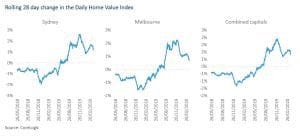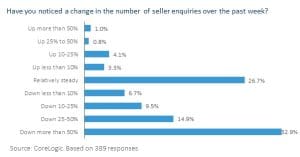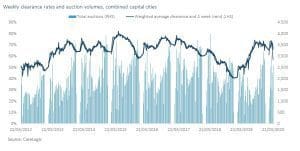Covid-19 property market report Provided By CoreLogic
The Product Data provided in this publication is of a general nature and should not be construed as specific advice or relied upon in lieu of appropriate professional advice. While CoreLogic uses commercially reasonable efforts to ensure the Product Data is current, CoreLogic does not warrant the accuracy, currency or completeness of the Product Data and to the full extent permitted by law excludes all loss or damage howsoever arising (including through negligence) in connection with the Product Data.

The past four weeks have seen rapid declines in the cash rate, several changes to fiscal and monetary policy, and a complete halt in business activity across specific industry sectors.
As daily updates roll out, enquiries around the state of the housing market have been mounting. Housing market and economic data from last month is largely redundant in capturing consumer and industry sentiment. The economic outlooks from last week are ancient history.
But CoreLogic has some daily and weekly metrics that provide more clarity around the state of the housing market right now. From survey data to platform metadata, a sudden, sharp slowdown in housing market activity is already apparent. The downside risk for housing values is also rising, especially considering forecasts that unemployment could reach around 11% over the next three months.
The decline in property price momentum has already been demonstrated in the daily index. The daily index shows a decline in rolling 28 day growth. Although the series remains in positive territory, the trend is clearly pointing towards a slowdown in growth that is likely to move into negative territory over the coming months.

But aside from the daily index values, CoreLogic has access to other high frequency datasets. This would show where housing market activity is heading.
We are surveying the industry
Between the 20th and the 22nd of March, CoreLogic surveyed 411 real estate professionals nationwide through its RP Professional platform.
The majority of respondents were real estate agents (52%), followed by agency principals (34%), property managers (8%) and administration (7%).
The immediate, stand-out response is that buyer enquiry has fallen sharply. The survey asked respondents as to whether they has seen a change in buyer equiry over the past week. 33.9% of respondents had seen a decline in buyer enquiry of more than 50.0%. This result is in line with a sharp decline in consumer sentiment and rising unemployment. This indicates that people are less confident or able to purchase property.

When asked about the change in seller enquiry over the past week, a third of respondents expressed that activity was down by more than half.

We are tracking leading indicators on listings
Metadata on the use of CoreLogic products can also be an indicator of market activity.
The CoreLogic Comparative Market Analysis report (CMA), is usually generated to help real estate agents with a listing campaign, because it has information about a property’s value estimate and nearby comparable sales. Therefore, the number of CMAs generated is usually a leading indicator of property listing volumes.
And CMA generation is falling sharply.
In the week to the 25th of March, the volume of CMAs generated fell 38%. Reports are down approximately 20% of where they were this time last year. This time last year was near the trough of the national property market downswing.
With public auctions banned, we will be watching activity closely this weekend
The week ending the 29th of March was expecting to see the highest volume of auctions this year. Across combined capital cites about 3,065 properties had been on shedule to be on auction.
With public auctions now banned, this weekend will be a test of how agents are able to facilitate auctions over the phone, via technology platforms.Otherwise, most auctions are expecting to experince a withdrawl and be on sale via private treaty
The final auction clearance rate for the week ending Saturday the 22nd of March was 56.9%, which was the lowest clearance rate result from June last year. This represents a decline of 8.4 percentage points from the previous week’s results.

Between lower clearance rates, CMA generations and industry sentiment, it is clear that the COVID-19 responses are deterring both property buyers and sellers. However, the government restrictions that impact the housing market are vital for limiting the spread of COVID-19. This thus reduces the burden on the Australian health system. While the situation unfolds, it is still unclear to what extent its impacting transactions and values. However, it is important to remember that the trajectory for housing will shift once the economy moves toward normal.
What’s next?
Find out more about what you can do as you navigate through these difficult times.
If you want to know more about your investment loan, home loan or construction loan options please leave your details below and we will be in touch.



